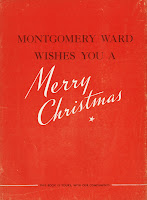 70 years ago, Montgomery Ward Company issued a small paper bound book to its various stores around the country. The book was a promotional item to be given away for free to kids who came to see Santa Claus. It was the story of a little misfit reindeer named Rudolph who turned the deficit of a large shiny red nose to an advantage and saved Christmas by leading Santa's sleigh through a foggy Christmas night.
70 years ago, Montgomery Ward Company issued a small paper bound book to its various stores around the country. The book was a promotional item to be given away for free to kids who came to see Santa Claus. It was the story of a little misfit reindeer named Rudolph who turned the deficit of a large shiny red nose to an advantage and saved Christmas by leading Santa's sleigh through a foggy Christmas night.The original story was penned by Robert L. May, Dartmouth Class of 1926. May, a copywriter for Wards, whose wife was suffering from cancer, conceptualized the story for his daughter Barbara to lift her spirits. May had always felt that he was a bit of a misfit himself. He was small and weak, was never picked first for sports teams as a child and never excelled socially, even as an adult. While his Dartmouth classmates went off to take high-powered jobs, he labored away as a lowly copywriter. May said that he modeled Rudolph on how he felt about his own life.
 May’s boss initially turned down the idea, but May persisted. He went to his friend Denver Gillen in the art department and asked him to mock up the story. His boss loved the idea. Wards began distributing the books on November 1, 1939 and quickly passed out 2,400,000 copies.
May’s boss initially turned down the idea, but May persisted. He went to his friend Denver Gillen in the art department and asked him to mock up the story. His boss loved the idea. Wards began distributing the books on November 1, 1939 and quickly passed out 2,400,000 copies.Production of the books ground to a halt during WWII, but Wards circulated them again in 1946, passing out an additional 3,600,000 copies. During the writing of the story, May's wife passed away. He later remarried, but was burdened by the debt he had accrued from his first wife's hospital bills. At the end of the 1946 run, Wards decided they had milked Rudolph for all it was worth. At the urging of a Vice President who knew of May's troubles, the Board of Directors turned the copyright over to May on January 1, 1947.

But Rudolph was far from spent. In 1948 an eight-minute animated film came out and in 1949, May's brother-in-law Johnny Marks composed the now classic song. In 1964 the "Animagic" TV special Rudolph the Red-Nosed Reindeer aired for the first time. It is still the longest running TV special in history. In addition, May licensed hundreds of Rudolph properties including toys, pens, mugs, music boxes, pajamas and dishware to name just a few examples
In the end, May's own story was more like Rudolph's story then he would have guessed when he first sat down to write it 70 years ago.
